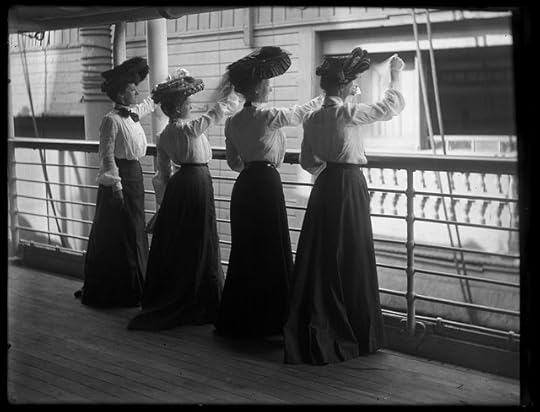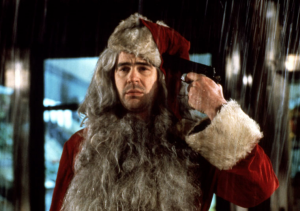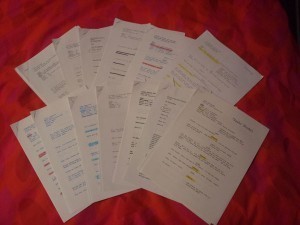R. Brandon Andersen's Blog, page 3
January 15, 2013
Saying goodbye to characters

I’ve spent the last week putting together a final revision for my book. The book was originally written for my friends, and starred them as characters. Everything about the story was fictional, but since it starred my friends, I forced some things to happen (and not happen) because I thought it would be rude to, say, kill one of them off in the story. “Hey I wrote a book with all of us in it. You die on page 10. Sorry.”
Now I’m transforming the story into something that will be public facing, and in the process the true story is coming out. As it turns out, one of the characters simply needed to die. I knew they had to die when I wrote the book originally, and I simply ignored the urge to make it happen. Again, I didn’t want to be rude to my friends.
So I sat down to write the scene today. I didn’t think it would be a big deal, I mean, it’s just a fictional character, right? I had already changed the names so it wasn’t even my friend’s name. It should be easy. Boy was I wrong.
The death unfolded slowly in the rewrite. In reading it, the scene probably takes about half a minute to get through. But writing it took what seemed like an inordinate amount of time. Killing off the character really brought about an emotional reaction. I was creating the character’s demise while at the same time saying in my head, “No! Somebody save him!”
It’s a very strange feeling; to destroy a character that you’ve worked very hard on (over a year’s worth of writing and rewriting). You miss the character right afterward, like you would a real person. But then it feels good to have the scene written and the way it should be. Like a final piece of the puzzle put in place.
Just thought I’d share how I was feeling about this. I don’t know if other writers have this same feeling when they write (if they do, Steven King must feel awful), but if you’re a writer I’d love to hear your thoughts on this.
The post Saying goodbye to characters appeared first on Brandon Andersen.

January 9, 2013
6 business writing tips I learned from creative writing
 I have a pretty cool day job where I get to share best practices in SEO, public relations, and marketing to the public. I do a webinar about once a month and write for my company’s blog. I’m blessed to work with great people who have taken me under their wings and showed me the ropes of how to create content and educate others.
I have a pretty cool day job where I get to share best practices in SEO, public relations, and marketing to the public. I do a webinar about once a month and write for my company’s blog. I’m blessed to work with great people who have taken me under their wings and showed me the ropes of how to create content and educate others.
Of all the wisdom that they’ve imparted, one of the most important skills that has helped me in my business writing is to loosen up on those old, stuffy academic/business rules and just write business content as I would creative content.
Here are 6 business writing tips that I use, and hopefully they can help you too.
Get it out of your head
The best advice I can give for business writing is exactly the same advice that I give to creative writers. Write. You can work on outlining first, if you’d like, but once the outline is done, some people still have no idea where to start or what to write. Make the choice to start somewhere, anywhere, and start putting thoughts down on paper. Move forward and don’t look back.
Be conversational
For the love of God, please stop using so much jargon. The stodgy academic approach to writing can be coma-inducing to a reader. If the idea is to impart knowledge on your reader, why not make it at least a little bit fun? Make your writing human-centric. Remember, it’s a person who’s reading it on the other side, not some AMA snob.
Don’t edit the first draft
The first pass isn’t going to be pretty. That’s okay. You’re just trying to get knowledge out of your head and down on paper. Usually the content is too short to find a “flow” like you can with creative writing, but sometimes you’ll catch a wave of creativity and ride it through to the end of the piece. If you don’t catch that wave, just keep trudging through the mud, you’ll get to the end soon enough.
The biggest trap here is to get in an editing loop. Ever started writing something, erased it, wrote something else, erased that, and then gave up entirely? Yeah, me too. Don’t edit; just write. You’ll have plenty of time for editing after you have a first draft done.
Revise
Once the ideas are down, it’s time to go back and edit. This is exactly what I do with creative writing as well. Organize your thoughts, clean up sentences, and add some nice breaks to make it easier to read.
Cut the crap
If you’re a little long-winded in places, cut it.
Add supporting materials
If you’re making a pretty broad claim, it’s probably worth adding some supporting material into your content. It’s like adding extra details into a creative story to explain a character’s actions. In both cases, this helps give credibility to your story.
What about you? Do you wear two hats in your writing: professional and creative?
The post 6 business writing tips I learned from creative writing appeared first on Brandon Andersen.

January 2, 2013
7 sources for story ideas

Finding story ideas can be tough sometimes. Sure, just about everyone has their million dollar novel idea, but shaping that idea into a true story and adding the detail to keep readers engaged can be daunting. Here are 7 sources for story ideas that you can use.
Overhearing/Eavesdropping
This sounds a lot worse than it actually is. Listen to everyday conversations that people are having. If you take public transportation, you’re riding in a gold mine of story ideas. Listening for just a few seconds of a conversation can give you an idea of what’s happening, who’s involved and how each person feels about it. It’s a great method to pick up characterizations too.
A simple way to do this without being a creep is to put in ear buds but not turn on music. People will think you can’t hear them and talk a little louder. Okay, maybe it is creepy, but it’s a great way to source story material.
Visual Observation
Pay attention to what’s going on around you. The world is full of stories that you can see unfolding in real time. You can then take these scenes and make them your own. See that woman walking down the street with the seven dogs on a leash? What’s her story? What could happen with her and those dogs?
Anecdotes/Gossip
These are stories that we hear from other people but we can make them our own with a little tweaking. No, it’s not stealing…it’s generating story ideas! When your buddy tells you the story of how his great uncle was in a nursing home and started biting nurses, you can take that idea and run with it. Is the uncle crazy? Maybe he just needs some lovin’? No, he’s just crazy.
Gossip is another great place for story ideas. Most gossip is made up anyway, and you know it’s a good story because it’s already something people are talking about. Cheryl’s older sister slept with her husband even though he’s gay and Cheryl’s been in a coma for six months? Go on…
News
Fact is stranger than fiction. Grab a newspaper (those still exist, right?) and thumb through some headlines. There are tons of ideas in there. Take one and run with it in your own way.
Dreams
Yep, dreams. Keep a pen and paper by your bed at all times. You’d be amazed at how many weird and fun stories come from dreams. I have quite a few pages of a notebook full of story ideas that came from dreams.
Memories
Memories are a great way to build a world around a story. Think back to something that happened to you. Then close your eyes and picture your surroundings. Start moving in each direction and really explore what’s there. It’s amazing how much your mind actually remembers.
There was a park across the street from my elementary school. To this day, I can tell you the location of the swing set, ball field, bike paths, swings, and even the trash cans. This detail can help you create a world for your reader too.
Research
Whether you’re writing fiction or non-fiction, researching people, places and things in history can conjure up all kinds of story ideas. You can also enrich your environments by researching real places. I’ve done this a lot using Google Maps, of all things. I researched a location for my second book and used Google Maps to map out where the characters went and how they got there. It’s amazing how exploring the area helped shape the story.
I hope some of these ideas help you create new stories. Happy writing!
The post 7 sources for story ideas appeared first on Brandon Andersen.

December 20, 2012
Fish out of water – Elements of Comedy
Scene from the classic fish out of water movie “Some Like It Hot”
When creating comedic scenes and premises, there are a lot of tried-and-true devices and formulas we can work with. One of my favorites is fish out of water.
So what does fish out of water mean?
It’s very much like it sounds. A fish out of water scene entails a character (the fish) being outside of their normal environment (the water). Look at some classic movies and you’ll see examples of this everywhere. One of my favorites is Trading Places, with Dan Akroyd and Eddie Murphy (they were so young and edgy then…ah…those were the days). Another is Being There, with the late, great Peter Sellers.
In Trading Places, Dan Akroyd is a yuppie, pretentious stock broker who has never worked a day in his life. Eddie Murphy is a homeless con man without a penny to his name. In the movie, they basically switch places (thankfully not because of magic and they don’t take over each other’s bodies). Eddie Murphy gets the pampered treatment and Dan Akroyd loses his job, fiance, house, and everyone he knows. Despite this sounding like some tragedy, the movie his hilarious. Even when Dan Akroyd tries to shoot himself in the head, we laugh. Why? Because we’re all sick.
Establish the character
The first step in a fish out of water scene is to establish your main character. Establish their normal. For some characters, we have assumptions of normal based on who the character is. For example, your character could be a priest. As readers, we have a preconceived notion of what a priest would and wouldn’t do, and where they would and wouldn’t go. Their normal setting is in a church, or a community center. Now, let’s mess with ‘em.
Change the environment
A priest doing his normal thing in a church doesn’t have much comedic potential. But let’s put that priest in a strip club. Now we’ve got something to work with. Just those two elements together have created tension. Tension, in physics, is equal to comedic potential (trust me on this, I’m a scientist).
You can get a character into a new environment without much work. In fact, you can just start with the character in the environment to start with – something a lot of sketch comedy scenes do. But this isn’t limited to just sketch. Think about scenes in your own writing. Are there places where the character can be drawn into some place where they normally wouldn’t go? Take them there.
Stay with the character
Keep telling the story from the character’s perspective. Describe their nervousness and apprehension. What’s happening to the character on the inside? How are they plotting to escape? Stay with them and let us experience the scene through their eyes.
Put them through hell

Dan Akroyd at his lowest in Trading Places
As humans, we’re a pretty sick lot. We like watching people go through terribly awkward things (see also: America Idol). It’s one of the foundations of comedy, because it builds tension. So how do we throw more comedy potential into the scene? We heighten it. That priest is now getting a lap dance (but let’s pretend he’s not enjoying it). We can keep heightening and heightening, but at some point the character would just walk away, right?
Give them a reason to be there
The character needs to have a reason to be in the scene. There is something that they are after that makes them willing participants in this strange world. That adds to the heightening and means that the character’s going to let the environment push him to the breaking point. It also speaks volumes to us, as readers, about the character’s will. It gets us on the character’s side. Now we’re cheering for him/her.
Let the character be won over
One way to end the scene is to have the character leave it. That’s not too funny. It removes the tension and doesn’t usually pay off.
The other (and better) way is to allow the character to be won over by his/her environment. With our priest friend, he might not fully embrace the idea of a strip club by making it rain on stage, but maybe he sets up a confessional next to the Champagne Room. Or, you know, something funny.
Scenes, sketches, movies, novels
Fish out of water is a well tested formula for creating tension and comedic potential. If you’re writing comedy, hopefully some of these tips above can help you pace out scenes and build some tension that results in some laughs. The nice thing about the formula is that it works on everything from short scenes to movies and novels.
Other examples of fish out of water
There are so many fish out of water stories out there that you probably already know. Here are just a few:
Blazing Saddles - A black sheriff in the old west
Some Like it Hot - Tony Curtis and Jack Lemon pose as women to win over Marilyn Monroe
Big - Tom Hanks is a boy trapped in a man’s body
Beverly Hills Cop – Eddie Murphy is a rough-and-tumble Detroit cop in Beverly Hills
The post Fish out of water – Elements of Comedy appeared first on Brandon Andersen.

December 14, 2012
Writer’s doubt – I’m kinda scared to publish
The original cover of the first edition of my book, “Mantrap”.
Doubt is that area of limbo between completely believing that we can do something, and totally believing that it’s impossible.
Last year I overcame a large self-doubt when I committed to writing a story that I had been thinking about the year before. It was a fun story based on me and a bunch of guys from college with whom I’m still very close. I was writing the book for them, and for myself. And I truly believed that I could write a story that I could be proud of, and one that would entertain those guys.
This year I finished the first version of the book (not first draft, mind you…it saw three rewrites and countless revisions) and presented it to my friends. The response was overwhelming. After getting great feedback on the book, I decided that I’d need to publish it. But first I would need to make a couple of changes to it. One of those changes was removing my friends’ names (and my own) and changing up a couple things in the story to make it a little bit less of a happy ending (killing all of my friends at the end of a book seemed to be a bit harsh, especially since it was a gift to them). I needed to be able to part with some characters. It was back to the revision process.
I haven’t touched the manuscript since I printed that first run of 20 books. That was four months ago.
What I’ve realized is that I’m scared to change this story. Not because it will change the book; the changes are actually for the better and I know they will make the story more well-rounded. But I’m scared that when it’s done, that it could fail. It’s not writer’s block. It’s writer’s doubt.
The next version of this book isn’t for my friends. It will be for the masses. It will be available for anyone to pick up or download. And those people, complete strangers, could love it or hate it. This time around, I simply don’t know how people will respond. It’s scary.
So it’s time to man up. Will people like the book? I hope so. Is it a good book? Yes, I think it really is. Should I stop making excuses to put in that final rewrite? You bet your ass.
(As added motivation, I added the cover from the original version of the book to this post. There, now everyone can see it.)
The post Writer’s doubt – I’m kinda scared to publish appeared first on Brandon Andersen.

December 8, 2012
3 sketch comedy tips that writers should use

Sketches for a 1-hour show.
The single best thing I’ve done to improve my writing was learning how to write sketch comedy.
Sketch comedy is the guerilla warfare version of storytelling. In sketch, you don’t have 50,000 words to tell a story. Or an hour. Or half an hour. You have to tell an entire story – beginning, transition, climax, and end – on a stage and in under 5 minutes. Ready? Go!
Given such insane constraints, sketch writers need to do three things that all writers should do:
1. Get to the point
The first thing that your sketch needs to do is establish the who, what, and where quickly. How quickly? The first 4 lines of dialogue. It’s called the four-line setup.
This is an excerpt from my sketch “3 Strikes You’re Out“.
Steve
Whoo! Way to to Thome! Ya! Send those Northside pricks packin! Buck up kiddo, the Sox are winnin’, you should be happy.
Brett
(Unenthusiastically)
Oh, yeah…Nice hit Thome.
Steve
Yeah! That a kid! Hey, you Northside pricks, pack your shit and go back to Wrigley you Old Style drinkin’ yuppies. Man, can you believe these guys still play in that shitty stadium of theirs? That place don’t even got a jumbo-tron.
Brett
Dad, there’s nothing wrong with Wrigley Field.
Who: A White Sox fanatic of a father & his apathetic son.
What: The son is not enjoying the game despite the father wanting him to. At the end, the son contradicts the father’s beliefs. If you watch the video, in two more lines comes the turning point.
Where: A baseball game (Thome is a White Sox player, so if you catch that, you know it’s a game between the White Sox and the Cubs in Chicago.)
2. This is the day
The sketch has to tell a story that is significant in the lives of its characters. The late Mary Scruggs would always tell us, “This is the day!” This is the day that these characters grow in some way. So make the plot significant. Is this the day where the husband and wife realize they’re meant to be together forever? That they’re not? That the husband is actually a woman with a hormone disorder? Why is this day significant to them? Heighten the conflict that goes along with such a momentus day; that’s what keeps an audience’s attention. The characters will end in a different place than where they started from at the beginning of the story.
3. Character wants and subtext
Characters can, and should be complex. Establish what your characters want. That gives them motivation to move forward, and therefore move your story forward. When we know what a character wants, we can get behind them and hope for their success, or hope that they fail. It gets the audience involved. If we don’t know what the characters want, the scenes will become stiff and lose the audience.
Knowing what your characters want also drives subtext to their actions. Dave may really want to eat the cookie that Jane has in her hand. To get it, he may hit on her or make a pass in some way. His actions come across to her as romantic, but we know that he only wants that cookie. Right there we have conflict, a relationship, and we want to know what happens next.
3.5. (Bonus) The knockout
A sketch or a story will really stick with you if it has a good button or knockout ending. What can happen at the end of the story that catches your audience by surprise? In sketch, it’s often a final one-liner before the blackout. The most obvious example from a movie is the ending of “The Sixth Sense.” The knockout at the end is what people remember most about it.
The post 3 sketch comedy tips that writers should use appeared first on Brandon Andersen.




